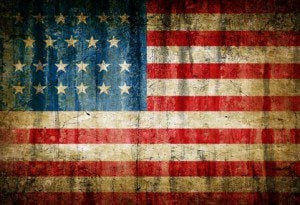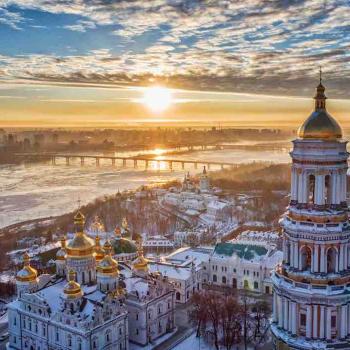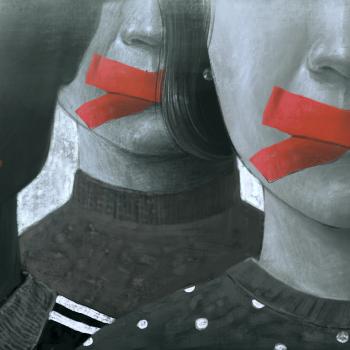Connor Wood
Robert Bellah, the sociologist of religion who popularized the idea of an American “civil religion,” died over the summer at the age of 86. In an age of stultifying political dialogue and rabid partisanship, Bellah’s passing marks an era when the American myth has, for many, lost a tremendous amount of its luster – and believability. But two recent events – a moon rocket launch and a presidential speech on Syria – remind us that myths take participation in order to be made real. While cynicism may rule the day in Congress and across the internet, I think that a little openness to the civic myths of our culture – or whichever culture you inhabit – is something the world can’t do without.
Let me clear up something right off the bat: civil religion isn’t the mixing of church and state. It is not the use of crucifixes and the Ten Commandments to advance a religious agenda, say, in public buildings. Instead, civil religion is, to paraphrase Robert Bellah, the shared reverence for sacred symbols drawn from a nation’s history. It is not, properly speaking, a “religion” in the way the word is used by most English speakers today. In the US, civil religion has traditionally revolved around symbols such as the Declaration of Independence, the flag, Martin Luther King, the Grand Canyon, or the Apollo moon landings. The use of, and reverence for, such symbols and myths is what links people emotionally to the larger society and inspires them to strive for its well-being.
Here’s where the story starts for me: it’s 1990, and I’m a 9-year-old kid living in Maryland, only a few hours’ drive from some of the most sacred sites in the American mythological corpus: the U.S. Capitol, the Smithsonian, the Liberty Bell – and also Antietam, Bull Run, and the Appomattox Court House. Right around then, Ken Burns’s documentary The Civil War aired on PBS. My family watched it religiously every night, following the story of the bloody conflict that took 600,000 American lives, tore the country apart, and became the fulcrum upon which the entire history of the United States would pivot ever since.
The thing was, Burns’s documentary was beautiful. Not because it made the war beautiful – it didn’t. War isn’t beautiful. But it made the story of the United States seem as if it actually meant something. Burns is a master storyteller. He used music, old photographs, and letters written home from soldiers to their wives and sweethearts to evoke the pain and sadness of the war. He used diary entries and private communications to provide shockingly personal glimpses into the inner worlds of Jefferson Davis, Ulysses S. Grant, and Abraham Lincoln himself. And throughout the entire 10-hour series, the haunting fiddle lament “Ashokan Farewell” transported viewers from their living rooms to the dusty, sun-beaten battlefields where brother fought against brother.
Burns’s documentary left me with a lifelong reverence for the history of this strange country and a desire to know what it might mean. Now, flash forward to recent years. Last November, in Chicago for a conference, I found myself having beers downtown one night with a professor of religion who could not have been more cynical about the Civil War. “The Civil War was just the first step for American imperialism,” he snorted. “It paved the way for the Spanish-American War. There was nothing noble about it. Just pure, rank imperialism.” Then he tossed back the last of his stout and looked at me pityingly.
Now, if you spend any time at all around universities you’ll know that “imperialist” is a blanket insult many academics bandy about to indicate that they don’t like something. But it’s also a clue to a deeper fault line running beneath the surface of our culture. The fact is, the United States is a deeply flawed entity whose actual history is nothing like the romantic visions of it conjured up by weepy Civil War fiddle melodies or Saturday Evening Post cover paintings. The U.S. has meddled tyrannically in the affairs of other countries, built its wealth on slavery and conquest, and – let’s not forget – achieved its economic dominance by exploiting the staggeringly abundant natural resources that were taken at gunpoint from American Indian tribes.
But there is one serious problem with stopping here, shrugging our shoulders, and saying, “Well, to hell with America, then.”* As the French sociologist Émile Durkheim argued, societies need sacred values and symbols if they are to survive. A society with nothing sacred binding it together will quickly degrade into merely an agglomeration of individuals, and unity – as well as the ability to effectively address problems – will evaporate. The fact is that sacredness – a sense of inviolability, reverence, and supreme value – is utterly necessary for group life to succeed. Groups whose membership is based on sacred beliefs, symbols, or myths will, all other things being equal, always outcompete groups whose membership is based on, say, mere mutual economic interests like owning stock in the same office-supplies manufacturer.
What I am trying to say is that, if the United States is to continue as an experiment in how to construct a society of equals, each of us must find some way to realistically overcome the cynicism that reality encourages and allow ourselves instead to be moved by the symbols of an America that never was, and never will fully be.
This – the ability to be moved by symbols of things that themselves are never realized – is the trick of participation in a sacred world. It is the great secret. Sacred things are not perfectly manifestable – but you have to allow them to move you anyway.
What would happen if we were hardnosed realists about everything, as my stout-drinking professor friend advocated? The anthropologist Roy Rappaport gave us a hint by pointing out that if we let reality – that is, how people actually behave – define our moral principles, we’d end up with no morals at all. For example: in most societies we have a moral principle that says that people shouldn’t kill each other. But that principle is an ideal. In real life, people actually do kill each other. It doesn’t happen too often, but it does happen sometimes. This means that the moral ideal of non-killing is objectively not realized in the actual world.
But if we decided to be strict realists and adjusted our moral guidelines so they matched what actually happens in real life, we’d end up with a deflationary cycle that would end with a radically weakened moral code. In fact, it wouldn’t be a code at all; it’d be more like a statistics printout. (“In an average year, 12 out of 100,000 people will be murdered. It is unacceptable to murder others unless the quota of 12 has not yet been reached.”)
In other words, when it comes to guiding people’s behavior within a social milieu, realism is not actually the way to go. We can’t just look at the ugly reality and say, “Oh, well, I guess murder is okay after all.” Instead, we retain our ideals, even in the face of contrary evidence. We do this by participating in the rituals and sacred stories that evoke these ideals. We can, and should, do this regardless of the weight of evidence against the ideal. Even if you lived in a horror movie world where everyone but you and your closest friends were murderers, it would still be right to affirm that murder is wrong.
The same is true for more complex and sticky ideals, like those of an abstract entity like “the United States.” The United States as an ideal claims to stand for freedom, equal opportunity, honor, wide-open spaces, industriousness, and so forth. The actual historical political body is deeply morally compromised, and it always will be. If Vietnam didn’t convince you, then the Tuskegee syphilis experiment ought to. But the question is, should the reality of the U.S.’s behavior prohibit you from feeling moved by its national symbols, affirming its values, or partaking in its mythology?
No. It shouldn’t. A few weeks ago, NASA launched an unmanned probe to the moon (we still had a government back then, you know, so we could do things like that). The launch happened in Virginia. I live in Boston, but because of the sheer height the rocket attained I got to see the actual rocket rising over the Eastern Seaboard at night,† a rust-red bright dot arcing above the lights of Boston. I was thrilled, but unexpectedly, I also felt deeply, deeply moved. My grandfather worked for NASA during the Apollo program. When I was a child, visiting the Smithsonian Air and Space Museum was like walking into the Hagia Sophia. This meant something. Our nation, a collection of individual human apes united under a bunch of objectively meaningless symbols, was reaching once more into the still waters of space.
The following Monday, I tuned into President Obama’s speech to Congress on Syria (remember Syria?). I am not a big news-watcher; in fact televised news often makes me recoil as if I had been forced to witness a raw grub-eating contest. So I am generally left out one of America’s traditional civil religion rituals: watching important figures say important things on television while, at the exact same time, millions of other Americans are (figuratively) right there beside me. This time was different. I watched the president’s speech, and although I was not sure I believed what he was saying, I felt as if I were somehow synced up with a country – a country I hadn’t really felt bonded to since I was a child sitting on a couch in Maryland, wrapped in a blanket, watching The Civil War on PBS.
I’m an academic. I know how far away reality is from our romanticized self-images, whether we’re talking about America’s calling as a freedom-ringing “city on a hill” or, say, the universal hope the Catholic Church believes it offers. All our institutions, all our nations, are corrupt. All our lofty ideals pale in comparison with the gaudy and stained colors of reality. But even as we live in reality, we can allow the ideals to live in us. Robert Bellah understood that a sincere belief in, and admiration for, the sacred symbols of the idealized American narrative was a vital ingredient in the functioning of our culture. As political battles reach new heights, and the fabric of the nation seems stretched to its breaking point, civil religion – responsible, earnest, and humble, fully aware of our tarnished history – might be exactly what we need.
Note: I apologize to readers from other countries for the U.S.-centeredness of this piece. It’s a subject that’s been weighing on me for a while. With the government shutdown, congressional battles, and various and sundry other political unpleasantries dominating the newspapers around here recently, I thought now was a good time to get it off my chest.
Edit: I added a paragraph to stress that “civil religion” is not the mixing of church and state, something that wasn’t entirely clear in the original version.
_________
* Although plenty of my friends do this.
† This was the awesomest thing ever.












